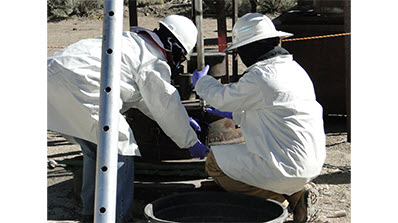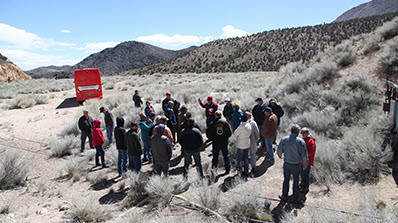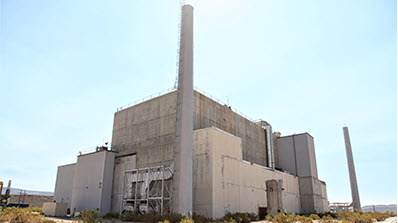The U.S. Department of Energy (DOE)Office of Environmental Management (EM) has published its 2021 Year in Review, summarizing the cleanup work completed across the DOE complex over the course of the year. The DOE EM Nevada Program was counted among the sites that made significant progress, after marking several major milestones in furtherance of its cleanup mission during 2021.
These accomplishments include:
- Initiated characterization and hazard reduction activities to prepare for demolition and closure of two legacy facilities at the Nevada National Security Site (NNSS)
- Obtained regulatory approval of data completeness for the Pahute Mesa groundwater region – the last active groundwater corrective action area at the NNSS
- Safely and securely disposed of approximately 550,000 cubic feet of classified and low-level (LLW)/mixed low-level (MLLW) radioactive waste in support of DOE cleanup and activities at federal sites across the U.S. involved in nuclear research, development and testing, and ongoing national security and science missions
- Completed the Area 5 Radioactive Waste Management Complex infrastructure expansion project to allow for future construction of LLW disposal cells
“The past year was foundational for EM’s work in Nevada. As we stand at the precipice of initiating our last major demolition and closure projects at the NNSS, we can also see the completion of our groundwater work and the close-out of our overall environmental restoration mission on the horizon. As always, I thank the dedicated federal and contractor professionals who continue to safely, securely, and successfully move our program forward,” said Rob Boehlecke, manager, EM Nevada Program.

Preparing for last major demolition work
In 2021, the EM Nevada Program and its environmental program services contractor began characterizing contamination and abating known hazards to prepare for the upcoming demolition and closure of two large legacy nuclear facilities on the NNSS. The facilities are the Engine Maintenance, Assembly, and Disassembly (EMAD) and Test Cell C (TCC) complexes, which supported historical nuclear propulsion rocket development and testing programs. The characterization and hazard reduction work being performed will help to ensure future demolition and closure activities at EMAD and TCC are conducted safely, securely, and successfully. Outlined in EM’s Strategic Vision for 2021-2031, the progress at EMAD and TCC represents the last major demolition and closure efforts currently identified in EM Nevada’s environmental remediation mission. The EM Nevada Program plans to mobilize for demolition at TCC and EMAD in 2022.
Key regulatory approval for last active groundwater area
In September, the EM Nevada Program earned approval of “data completeness” from the Nevada Division of Environmental Protection (NDEP), a key step necessary to advance environmental corrective action strategies at the Pahute Mesa groundwater area. Under the Federal Facility Agreement and Consent Order — a regulatory agreement governing EM cleanup strategies at the NNSS — an assessment of “data completeness” lies between the collection and analysis of field data and the start of advanced scientific modeling.

This field data serves as a gateway for understanding the nature and movement of groundwater at the NNSS. The data collected by EM Nevada, analyzed by experts and reviewed by NDEP includes information related to groundwater chemistry, pressure levels, subsurface temperature and geologic properties. With initial data collection and analysis complete, EM Nevada experts have begun developing sophisticated scientific models to forecast where and how contamination might move within the groundwater under Pahute Mesa.
Groundwater contamination at the NNSS is the result of historical underground nuclear testing conducted from 1951 to 1992. To date, EM Nevada has succeeded in transitioning three of four main groundwater regions at the NNSS to long-term monitoring — only Pahute Mesa remains in the corrective action investigation stage. Decades of testing, analysis and modeling have resulted in an extensive understanding of the nature and movement of groundwater under the NNSS. As a result, current research shows that contaminated groundwater will not reach public water supplies.
EM Nevada projects that the Pahute Mesa groundwater corrective action region will transition to long-term monitoring by 2028. It is currently anticipated that regulatory closure of the Pahute Mesa groundwater area will complete EM’s currently identified environmental restoration mission in Nevada.
For more information on EM Nevada Program activities, please visit the NNSS Environmental Programs homepage.

